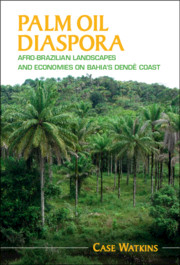Book contents
- Palm Oil Diaspora
- Afro-Latin America
- Palm Oil Diaspora
- Copyright page
- Contents
- Figures
- Tables
- Preface and Acknowledgments
- 1 Assembling an Afro-Brazilian Economy
- 2 African and Atlantic Worlds
- 3 Creolization
- 4 An Afro-Brazilian Landscape
- 5 South Atlantic Exchange
- 6 Landscapes, Religions, Transitions
- 7 Complexity
- Epilogue
- Bibliography
- Index
- References
Bibliography
Published online by Cambridge University Press: 20 May 2021
- Palm Oil Diaspora
- Afro-Latin America
- Palm Oil Diaspora
- Copyright page
- Contents
- Figures
- Tables
- Preface and Acknowledgments
- 1 Assembling an Afro-Brazilian Economy
- 2 African and Atlantic Worlds
- 3 Creolization
- 4 An Afro-Brazilian Landscape
- 5 South Atlantic Exchange
- 6 Landscapes, Religions, Transitions
- 7 Complexity
- Epilogue
- Bibliography
- Index
- References
Summary

- Type
- Chapter
- Information
- Palm Oil DiasporaAfro-Brazilian Landscapes and Economies on Bahia's Dendê Coast, pp. 285 - 336Publisher: Cambridge University PressPrint publication year: 2021

